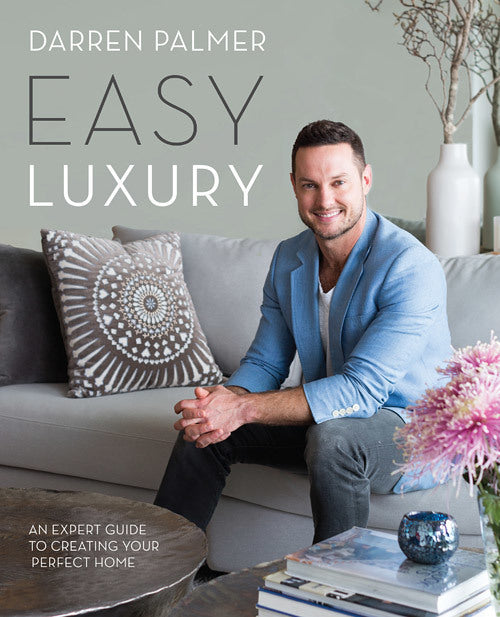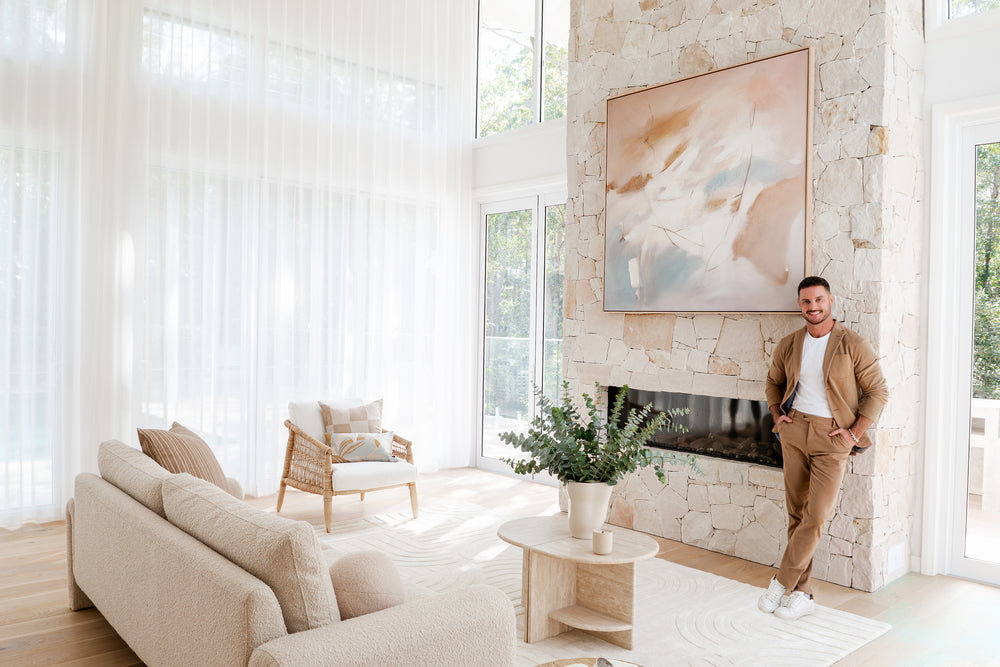Darren Palmer’s Easy Luxury


Darren Palmer's first book, Easy Luxury (Murdoch Books, $39.99), is an ode to the style he loves - comfortable, beautiful and polished yet still down-to-earth. It features images by Felix Forest from Darren's own interior design projects (he runs his own practice, Darren Palmer Design Studio) and a plethora of practical tips and solutions. Karen talked to Darren about the idea of luxury and the important of planning your design.
Much of your book’s philosophy is based on the Coco Chanel quote ‘Luxury must be comfortable, otherwise it is not luxury’. What is it about this statement that resonates with you so strongly?
That's a happy coincidence but it does reflect my ethos really well. There is no point living in a museum of beautiful things that you need to tread delicately around. I see no joy in having a home where you chastise your kids or pets or guests for being comfortable in your home so why would you encourage that?
For me a home should be somewhere that lifts your spirits, gives you a sense of prosperity and wellbeing and generally provides you with a beautiful sanctuary from which to live your personal life - kids, pets, spouses and friends included.

How important do you consider the fundamentals, the foundations of design
If you don't know why something works you may fumble your way through a myriad of bad decisions, ending in a lacklustre or even worse, ugly place, where your home has no bearing on what you desired. It may not end up reflecting your true personality, not because the parts don't work for you, but because the sum of the parts is not congruent. It's the way things interrelate that makes them sing, so it's only through understanding why things work that you can make good, sound and strong decisions that lead you to a beautiful and coherent result.

When is it appropriate to opt for a dark room and what are the rules around it?
If you already have no light then feel free to use that to your benefit. Light the room moodily so that you play on the areas of dark and shade; it's the contrast that brings interest so revel in the opportunity to contrast the very dark with bright and light. Pools of light work beautifully to highlight special pieces like artworks, sculpture or furniture.
Layering in textural contrast, too, will give you a warm and sensual space to feel cosy in. Bedrooms in my opinion are wonderful when they're dark so if you're faced with a dark bedroom then play on this sensuality.

Bathrooms have become more generous – more like spas. What tips do you have for achieving a luxe look?
Texture, whether it be visual or tactile or both, is the key. Natural timber, stone, patterns or shapes will all add interest, but choose the ones that stimulate as well as calm. The sense of luxury comes from the space feeling like an island of tranquility from where you can shut out the rest of the world, close the door, light some candles and soak away your stresses.
There are so few moments of privacy and stillness afforded these days the bathroom is a prime location to get a little luxury me time. I love nothing more than the feeling of warm water on my skin.

You discuss the importance of ‘mapping out’ where furniture pieces and lighting will sit. How would people approach this process in their own home?
It depends on the person but you can approach it from the tech savvy point of view by using Google SketchUp or similar software, creating or adapting a to-scale floor plan and placing in the to-scale furniture pieces so you know how they fit.
You could do it old school style by drawing a to-scale plan on graph paper and plot out the dimensions of the furniture in pencil, so you can relocate things simply by rubbing them out, or you can go the heavy lifting route and get a friend and physically move your existing pieces around to find the best layout for your current furniture. Always, always, always plot out any new pieces on a plan though to be sure they fit into the space and allow proper flow around them visually and physically. Don't make the rookie mistake of forgetting to measure your doorways, staircases, lifts and other access pathways to be sure the piece you love in store doesn't end up jammed in a doorway on it's unsuccessful journey into your home.

Texture is very important in your work and, as in this photograph (above), can evoke a soft, sensuous atmosphere. How do you approach layering with fabric, wall covering and flooring?
How do you not! The key is to look at each element in a room as an opportunity for impact - the walls, floors, linen, furniture, decor and lighting are all opportunities to add colour, texture, complement and contrast. It's measuring each piece for its particular part in this play of finishes that is the challenge. Too much and the room is a visual explosion, too little and it's a symphony of beige.

You have decorated grand-scale homes but you also pay attention, in the book, to the interior design of mid-sized rooms. What are the three key pieces of advice it is worth observing?
Measure your impact. The bigger the room the more moderate the impact should be for wall treatments in terms of pattern and texture.
Have a focal point - this could be an artwork, rug, furniture piece, light or an architectural feature such as a fireplace but start with one big impact and work back from there so you don't have too many statements fighting for your attention.
Choose appropriate elements for inclusion, the right sized rug, the right sized furniture and be sure everything gets along well with each other.

Lamps, whether sculptural when turned off, or creating ambient light when turned on are very much part of your decorating style? Should we be buying lamps in pairs?
Oh yes! I always buy lamps in pairs unless it's a particularly strong design and can stand alone on a console or sideboard. If you don't use both it's no problem to store one away but you'll never be sorry if you redo a room to have another pair of lamps to choose from to complete the space. Lamps in pairs for sure.
You speak of passion, and fun – how do you balance these attributes with informed decision making and sensible design choices?
The two things go hand in hand. It's like a child jumping on a trampoline. The trampoline needs to be designed well, be strong, be safe and do the job it is supposed to do so that the child can bounce around with happy abandon. The two things support each other. There's no point having a perfectly sensible room without joy nor is there any joy in having a crazy fun room that doesn't work.
Quick fire questions
I would happily never see a glass of rosé again. Drank way too much of it on my trip to France. On an interiors note I would be happy to see the back of many popular interiors fads but they come and go with regularity so there's no need to get hung up on them.
My ‘go to’ paint colour is anything with a grey base, de-saturated. whether it be pastels, mid-tones or deep hues - they all look best with a darker mood underneath them.
I always buy a good pair of shoes when I see one. I have a lovely shoe collection and they're pure design.
NATURE never fails to inspire me. It is my major aesthetic inspiration.
I know to stop adding to a scheme when it works. Until then just add things, take away, compare, assess, add more, take away and play until it feels right.
Follow Darren via Facebook or Instagram @darrenpalmerinteriors.
Originally published as: https://www.templeandwebster.com.au/style-and-advice/Darren-Palmers-Easy-Luxury-E10116







Leave a comment